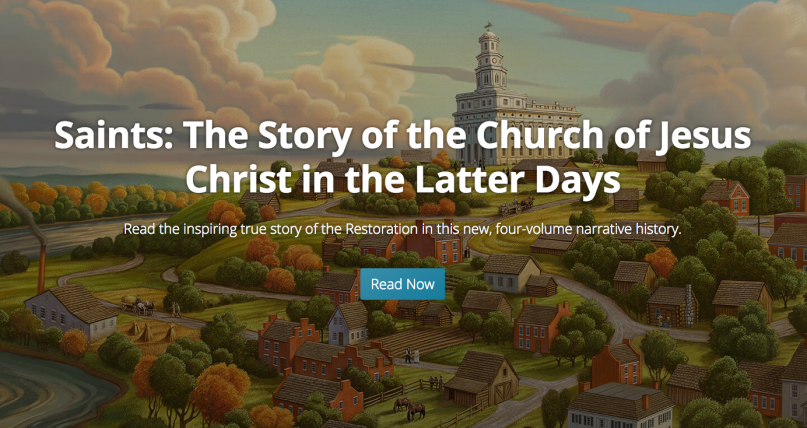After my daughter was born, I could always tell which of my fellow Mormons had read The Work and the Glory novels by the way they a) immediately associated the first name Jerusha with Hyrum Smith’s first wife and b) assumed (wrongly, as it happened) that reading that nine-book series was how I fell in love with the name.
The Work and the Glory made for terrible history: sanitizing, hagiographic, and undocumented. It wasn’t especially strong fiction either, for that matter. But it filled a need, which explains why it was so popular among Mormons twenty years ago, with Relief Society sisters trading the large hardback volumes back and forth to each other after church.

The front page of the new website for “Saints,” a history of the Church of Jesus Christ of Latter-day Saints.
Today, the Church of Jesus Christ of Latter-day Saints releases the first of four volumes in a narrative history that’s the first “official” such history since 1930. I hope every member of the Church will read it. The first installment of Saints is nearly 700 pages with all the back matter, so I’ve only read it impressionistically so far, but I’m impressed for several reasons.
The stories are memorable.
The need that The Work and the Glory filled but nonfiction histories generally had not was to satiate our human demand for story. The novels from twenty years ago aimed to flesh out a history of the Mormon people that would hint at larger-than-life historical figures being real people who lived and loved and had complex emotions.
With Saints, the Church is aiming for that same audience: the everyday Mormon who would like to know more about our religion’s history but isn’t that interested in wading through traditional historical apparatus like footnotes. People want stories. And orthodox Mormons are often too scared of wading into “unofficial” waters that may include faith-damaging information.
Enter Saints, which offers Mormon storytelling from an approved source: the Church itself. To their everlasting credit, the folks behind Saints hired professional storytellers to help them write history as story (including two friends of mine, playwright Melissa Leilani Larson and Garden of Enid comic wunderkind Scott Hales, so heck yes I am biased).
It’s engagingly written. Saints is a history that reads at times like a novel, with dialogue and glimpses of distinct characters: Hyrum Smith, for example, emerges as the peacemaker among the Smith siblings, whereas William is a firebrand. (The story of William physically attacking Joseph at a debating society meeting is not one I’ve heard in sacrament meeting in, um, the history of ever.)
There’s greater honesty about the past than we’ve seen from the Church’s curriculum.
Remember when LDS historian Leonard Arrington was chastised because in his biography of Brigham Young he mentioned that Young chewed tobacco for much of his adult life? The thinking among certain Mormon leaders in the past has been that if a historical fact is not explicitly faith-promoting or doesn’t correspond exactly with the Church’s teachings now, it’s not to be included as history.
Thankfully, Saints largely moves beyond that.
Joseph Smith drank alcohol on occasion, the book mentions in a matter-of-fact way, and he and Emma sometimes consumed coffee and tea even after the Word of Wisdom was received as revelation. Polygamy was a hard, hard, hard teaching to live, and the pain of it brought Joseph and Emma’s marriage to the brink.
The overall message of faith outweighs the human flaws in this narrative, but the flaws are there, real and necessary, and I’m grateful they haven’t all been glossed over. Moreover, some of the stories are available on the Saints website, arranged topically for people who are preparing a Church lesson:

Supplementary material available on the “Saints” website.
The Church is really, really trying for more diversity.
The eight contributors credited at the beginning of the book are all men, though the next page lists several women who served as writers, historical researchers, and editors. As a historical artifact in its own right, Saints will be remembered for this effort to include women in this particular way, because it encapsulates Mormonism’s unique historical moment at the beginning of the 21st century: the Church is trying hard to include women, but it is not yet ready to give them leadership roles or put them in charge of men.
Also, while Saints makes a valiant effort to (finally!) incorporate minority voices and experiences as vital to the early history of the Church, representation is pretty thin on the ground in terms of the writers and editors. Almost everyone involved in the project is white, and the authorship of this volume at least seems exclusively American. I don’t know if that will change as later volumes bring the story to the explosion of international diversity that has happened within Mormonism in the last half century, but I certainly hope so.
Overall, there’s far greater diversity here than we’ve seen in any previously correlated history from the Church. Elijah Able gets his due as an African American missionary who held the Melchizedek priesthood in the 1830s; Jane Manning James’s great faith is featured. What’s more, the reality of white Mormons’ racism is at least acknowledged in places, like when Jane’s family had to walk from New York to Nauvoo because their branch president would not loan them the boat fare (none of the white converts on the boat were asked to pay in advance).
These can be hard stories to hear, but preserving them is vital; not all Saints were saints.
Related posts:
- Best. Mormon. Comic.
- The Mormon reinvention of Emma Smith
- Mormon founder turned over the keys to women, says Deseret Book author






